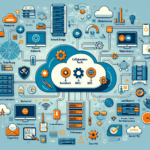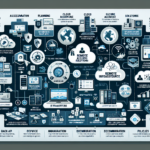Configuring a secure IT infrastructure for document collaboration requires a multi-layered approach to ensure data integrity, confidentiality, and accessibility. Below is a comprehensive guide tailored to your expertise as an IT manager overseeing datacenter, storage, backup, servers, virtualization, Windows, Linux, Kubernetes, AI, IT infrastructure, and GPU graphic cards.
Step 1: Assess Requirements
- Understand Collaboration Needs: Identify the number of users, types of documents, access levels, and collaboration tools.
- Compliance: Ensure the solution meets regulatory requirements (e.g., GDPR, HIPAA, ISO 27001).
Step 2: Design the Architecture
- Centralized Storage:
- Use a high-performance NAS or SAN storage solution for document management.
- Implement file systems optimized for collaboration, like SMB (Windows) or NFS (Linux).
-
Optionally, use object storage (e.g., MinIO or AWS S3) for scalability and modern applications.
-
Virtualization:
- Deploy collaboration tools on virtual machines (VMs) using VMware, Hyper-V, or KVM.
-
Isolate workloads for different teams/departments to enhance security.
-
Server Configuration:
- Use enterprise-grade servers with redundancy (RAID) and high-speed storage.
-
Deploy load balancers for high availability and failover protection.
-
Kubernetes Integration (Optional):
- Host containerized document collaboration apps (e.g., Nextcloud, OnlyOffice) on Kubernetes clusters.
- Use GPU-enabled nodes if AI-powered document tools (e.g., OCR, translation) are required.
Step 3: Collaboration Tools
- Choose a Secure Platform:
- Microsoft SharePoint or OneDrive for Business (Windows-based environments).
- Nextcloud or ownCloud for open-source and Linux-based environments.
-
Google Workspace or Dropbox for cloud collaboration.
-
Permission Management:
- Implement role-based access control (RBAC).
-
Configure granular permissions for document access, editing, and sharing.
-
Encryption:
- Enable encryption at rest (e.g., BitLocker for Windows, dm-crypt for Linux).
- Use TLS/SSL for data in transit.
Step 4: Secure Access
- Identity and Access Management (IAM):
- Integrate with Active Directory or LDAP for centralized user authentication.
-
Use Single Sign-On (SSO) and Multi-Factor Authentication (MFA).
-
Secure Remote Access:
- Deploy VPN for secure document access outside the network.
- Consider ZTNA (Zero Trust Network Access) for modern secure access.
Step 5: Backup and Disaster Recovery
- Backup Strategy:
- Implement incremental and full backups for documents.
-
Store backups in isolated environments (e.g., air-gapped systems).
-
Disaster Recovery Plan:
- Use snapshot technology (e.g., VMware, ZFS) for fast recovery.
- Test recovery procedures regularly.
Step 6: Monitoring and Logging
- Deploy monitoring tools for infrastructure and collaboration platforms (e.g., Prometheus, Grafana).
- Enable logging and auditing to track document access and modifications.
Step 7: AI Integration (Optional)
- If using AI-powered tools for document collaboration:
- Deploy AI models on GPU-enabled servers for tasks like summarization, translation, and OCR.
- Use Kubernetes for scalability and GPU resource management.
Step 8: User Training and Policies
- Train users on secure document handling.
- Establish policies for data sharing, password management, and acceptable use.
Step 9: Regular Updates
- Patch collaboration platforms and underlying infrastructure frequently.
- Update security software (e.g., antivirus, firewall) and firmware.
Step 10: Conduct Security Assessments
- Perform regular vulnerability scans and penetration testing.
- Conduct audits to ensure compliance with security standards.
Sample Tools and Technologies
- Storage: Dell EMC, NetApp, QNAP, MinIO
- Virtualization: VMware vSphere, Microsoft Hyper-V, KVM
- Collaboration Platforms: Microsoft SharePoint, Google Workspace, Nextcloud
- Access Management: Okta, Azure AD, Duo Security
- Backup: Veeam, Commvault, Rubrik
- Monitoring: Prometheus, Grafana, SolarWinds
- AI Tools: TensorFlow, PyTorch, OpenAI APIs
By implementing these steps, you will create a secure, reliable, and scalable infrastructure for document collaboration.



